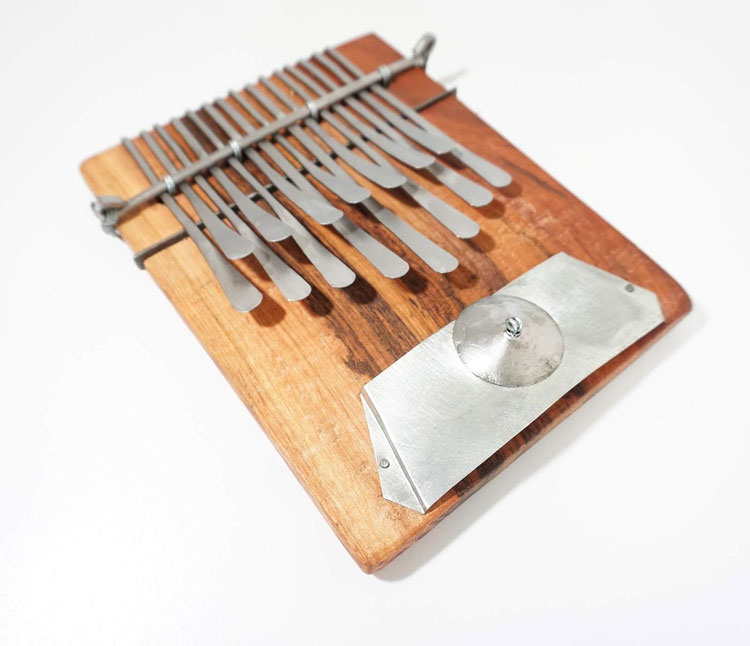The mbira, also known as the “thumb piano,” is a distinctive Zimbabwean percussion instrument. As an idiophone, it features resonant solid components integrated into its own body. Its name, “mbira,” which is often translated as voice of the ancestors, derives from the Shona language of Zimbabwe, a region where this instrument has a rich history. Similar instruments are found throughout Africa with different names: sanza, kalimba, likembe, etc.
Delving into its historical and cultural significance, the mbira has been an integral part of African societies for millennia. Traditionally, it was crafted from wood or bamboo; however, approximately 1,300 years ago, metal keys were introduced along the Zambezi River, spanning what is now Zimbabwe and Malawi. This innovation facilitated its widespread adoption across Africa, where it remains beloved to this day. The number of keys varies. Modern mbiras may include 15 to 37 keys.
Mbira music plays a pivotal role in various ceremonial functions, encompassing weddings, funerals, and the honoring of significant individuals. Moreover, it holds religious relevance, typically serving as a medium to invoke spirits and seek their guidance. In certain African ethnic communities, elaborate religious ceremonies, involving continuous singing, dancing, and musical performances, would persist until the spirits manifested. These rituals would momentarily halt upon the spirits’ presence and then resume.
The technique for playing the mbira involves plucking its metal keys with the thumbs and one finger, hence the moniker “thumb piano.” These keys are affixed to a wooden board, functioning as a resonator, yielding a distinctive and mesmerizing sound that is instantly recognizable.
Centuries ago, court musicians were entrusted with playing the mbira for Shona kings and their diviners. Presently, the mbira enjoys widespread popularity throughout Zimbabwe, renowned for its ability to bestow qualities such as tranquility of mind and a robust life force.
To become a professional mbira player, referred to as a gwenyambira, is seen as a service-oriented role. The gwenyambira is considered a conduit for the spirits, playing music on their behalf.
Some of the finest mbira players include Dumisani Maraire (1944 – 1999), Cosmas Magaya (1953 – 2020), Ephat Mujuru (1950 – 2001), Stella Chiweshe (1946 – 2023), Chartwell Dutiro (1957 – 2019), Bezil Makombe, Garikayi Tirikoti, mbira group Mbira DzeNharira, The Zonke Family, Hakurotwi Mude (1940s – 2008), Hope Masike, Forward Kwenda, Chiwoniso Maraire (1976 – 2013), Chaka Chawasarira, Newton Gwara, the late Sekuru Gora (1937 – 2002), David Gweshe, Fradreck Mujuru, Tute Chigamba, Musekiwa Chingodza, Beauler Dyoko (1944 – 2013), and Shorai Dutiro.
World music star Thomas Mapfumo & The Blacks Unlimited popularized the sound of the mbira internationally through their numerous albums and frequent tours of the United States and other countries. Mapfumo’s band featured top mbira players such as Chartwell Dutiro who used amplification on their mbiras.
Notably, American musician Chris Berry, who received training in Zimbabwe, has pioneered an electric version of the mbira.
(headline image: 15 Key Shona mbira, nyunga nyunga style)
Mbira Books
Playing the African mbira by Carol Burt-Beck (1979)
The Soul of Mbira: Music and Traditions of the Shona People of Zimbabwe by Paul F. Berliner (1993)
Mbira’s Restless Dance: An Archive of Improvisation (Chicago Studies in Ethnomusicology) by Paul F. Berliner and Cosmas Magaya (2020)
The Mbira: An African Musical Tradition by Mahealani Uchiyama and Patience Chaitezvi Munjeri (2021)
The Little Mbira Book by Fesseha Demessae and Forward Kwenda (2023)


